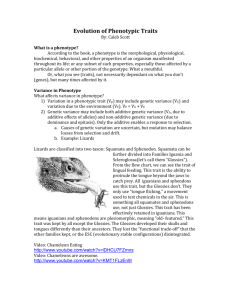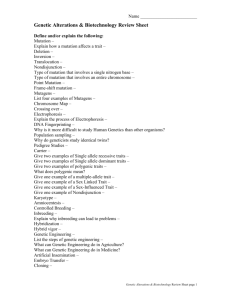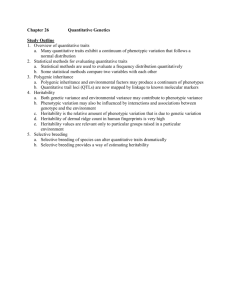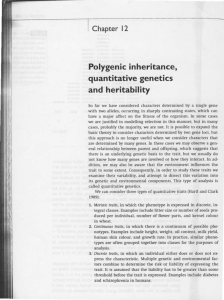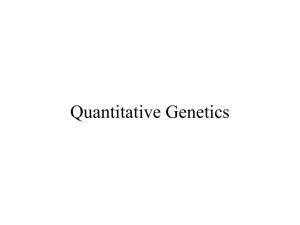Inheritance of a Single Trait & Response to Selection
advertisement
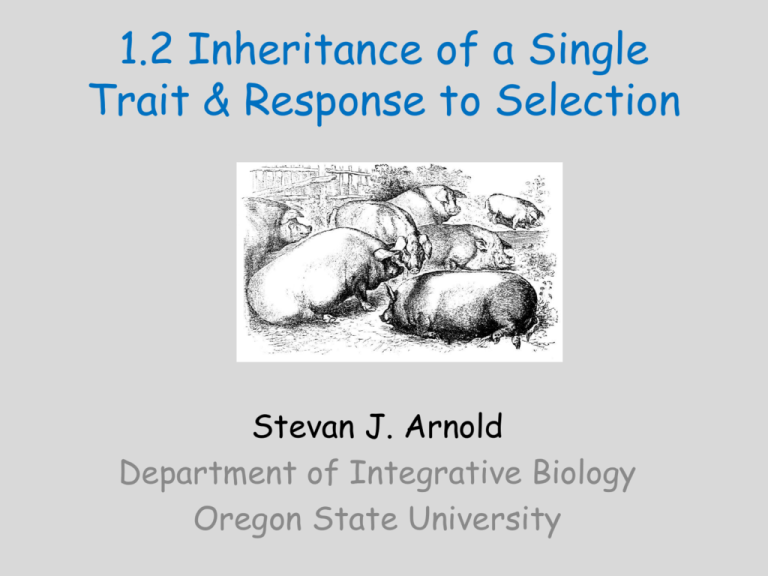
1.2 Inheritance of a Single Trait & Response to Selection Stevan J. Arnold Department of Integrative Biology Oregon State University Thesis • Most traits are affected by many genes • We can model the inheritance of such traits with a statistical approach • Additive genetic variance is the statistical concept that enables us to model both inheritance and response to selection Outline 1. Phenotypic resemblance between parents and offspring reveals heritable variation. 2. To understand resemblance we need a model. 3. Some examples. 4. Why don’t we run out of additive genetic variance? 5. Changing the trait mean with selection. 1. Phenotypic resemblance: Galton’s plot 2. A Model of Phenotypic Resemblance a. A model for phenotypic value (from Joe’s lecture this morning) b. An equivalent model, without the locus-by-locus details, for phenotypic value phenotypic mean phenotypic variance 2. A Model of Phenotypic Resemblance c. A new perspective on Galton’s regression Our model identifies additive genetic variance, G, as the key statistical property responsible for Galton’s regression 2. A Model of Phenotypic Resemblance d. What about resemblance between other kinds of relatives? We need to include domiance, d, and epistasis, i, as well as additive effects, x to obtain a general expression for resemblance between relatives X and Y 3. Some examples Frequency a. Mother-daughter resemblance in vertebral counts in garter snakes Body vertebral count 3. Some examples Daughters’ tail count Daughters’ body count a. Mother-daughter resemblance in vertebral counts in garter snakes h2 = 0.54 Mom’s body count h2 = 0.48 Mom’s tail count 3. Some examples b. A survey of heritability estimates Frequency n = 580 Heritability estimate 4. Why don’t we run out of additive genetic variance? Mutation-Selection Balance Mutation Recombination Linkage disequilibrium Expressed variation Stabilizing selection Hidden variation stored in negatively linked combinations of alleles Stabilizing selection 4. Why don’t we run out of additive genetic variance? Mutation-Migration-Selection-Drift Balance Mutation Migration Recombination Linkage disequilibrium Expressed variation Stabilizing selection Drift Hidden variation stored in negatively linked combinations of alleles Stabilizing selection 5. Changing the trait mean with selection Offspring values a. Response to selection as a regression problem Heritability = ℎ2 Midparent values 5. Changing the trait mean with selection Offspring values a. Response to selection as a regression problem Selection differential 𝑠 = 𝑧∗ − 𝑧 Midparent values 5. Changing the trait mean with selection Lineage mean b. Response to selection in a finite population Animation Generation 5. Changing the trait mean with selection c. Response to long term selection for bristle numbers in Drosophila What have we learned? 1. Additive genetic variance, G, is the key to understanding resemblance between parents and offspring. 2. Consequently, G is also the key to modeling response to selection. 3. G is nibbled away by selection but restored by mutation (and migration). References • • • • • • • Galton, F. 1889. Natural Inheritance. MacMillan, New York. Lande, R. 1979. Quantitative genetic analysis of multivariate evolution, applied to brain: body size allometry. Evolution 33: 402-416. Cockerham, C. 1954. An extension of the concept of partitioning hereditary variance for analysis of covariances among relatives when epistasis is present. Genetics 39: 859-882. Arnold, S. J. and P. C. Phillips. 1999. Hierarchial comparison of genetic variancecovariance matrices.II. Coastal-inland divergence in the garter snake, Thamnophis elegans. Evolution 53:1516-1527. Mousseau, T. A. & D. A. Roff. 1987. Natural selection and the heritability of fitness components. Heredity 59: 181-197. Lande, R. 1976. The maintenance of genetic variation by mutation in a polygenic character with linked loci. Genetical Research Cambridge 26: 221-234. Mackay, T. F. C., R. F. Lyman & F. Lawrence. 2005. Polygenic mutation in Drosophila melanogaster: mapping spontaneous mutations affecting sensory bristle number. Genetics 170: 1723-1735
